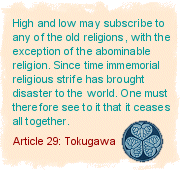
|
|
Confucianism
Came from China around 285, and became an accepted part of state theory
influencing social and political behaviour. During the Kamakura
period it had a strong effect on Bushido
(the code of honour for the samurai, 'The way of the warrior'). |
|
Shinto
'The way of the Gods' - Originated from Japanese mythology.
The 'Sun Goddess' Amaterasu, is the chief
deity, first born of the gods who created Japan.
Her great-great-grandson Jimmu was the
first Emperor, the 'Son of Heaven', divine ruler. Shinto worship
is of nature and past family members. Kami,
(Spirits), inhabit all elements of nature; trees, water, mountains,
animals etc. Heaven is above and below is the realm of the dead.
Practising ritual requires purification of hands and mouth with
water. The clapping of hands attracts the gods to hear prayer. Simple
gateways, torii, (usually painted red)
mark the entrance to Shinto shrines. Priests wear white.
|
Buddhism
Introduced from Korea and China in the 6th century. Civil war erupted
because of the perceived threat to Shinto. The pro-Buddhist Soga
family were victorious in 587 and the ruling Emperor was assassinated
to be replaced by Prince Shotoku, who declared
Buddhism the state religion in 594.
Throughout the following centuries notable Japanese monks developed
the concepts of Buddhism into specifically Japanese schools, Shu
(sects). |
Tendai
805 |
Founded by Saicho
(767-822) (posthumously, Dengyo Daishi).
Based on Mount Hiei near Kyoto. The torment
of hell (demons in bodily form) had to be countered with ritual and
offerings.
The priest Genshin (942-1017), added an
afterlife of paradise to the possibilities. Priest Ryonin
headed an important temple in Osaka. |
Shingon
806 |
Founded by Kobo
Daishi, Priest Kukai (774-835).
Original centre at Mount Koyasan. |
| Amida |
Founded by the monk Kuya
(903-972). Practised constant repetition of the 'Nembutsu' a phrase;
'Namu Amida Butsu' (Homage to Amida Buddha)
|
Jodo
Pure Land |
Founded by Honen
Shinran (1173-1262). Denied the existence of hell. Practised
invocation of the Bodhisttva Amida, the 'Redeemer'. Reverence to Amida
assured passage to the 'Pure Land'. |
Lotus
1253
Nichiren |
Founded by the monk Yakuomora
(Nichiren) (1222-82). He simplified worship
demands to a set of words from the Lotus Sutra.
Nichiren was born to a poor fishing family but later became a monk
of the Tendai sect. After denouncing their teachings he was driven
from Mount Hiei, and branded a troublemaker. And then, following an
attack on the Bafuku, he was arrested and
exiled. He then formulated the Lotus sect and on his return in 1263,
found that he had many followers. Persecuted still for his teaching,
he was condemned to death in 1271. He was saved by a 'miracle' when
lightning struck his executioner's sword. He was pardoned but exiled
again to spend three years on the island of Sado. When fully pardoned,
he returned and retired to the slopes of Mount Fuji in 1274. He then
devoted himself to propagating the Lotus Sutra through his many followers.
His adopted name was formed from: Nichi
(sun) Ren (lotus). |
Zen Buddhism
A contemplative doctrine from China (Ch'an).
Daruma was a monk and founder of Zen in
the 6th cent.
Legend says that he meditated for so long his arms and legs disappeared.
Today, he is represented as a red ball with large eyes.
Allied to Taoism, not wholly religious (no rites or sacred texts).
Seeks 'enlightenment', satori, through
the freeing from known logical thought. Koans
(illogical riddles), required the novice to challenge natural thinking
processes. Teaching self discipline it combined Confucian philosophy
with Chinese mysticism, this appealed to the warriors of the Kamakura
period. |
Rinzai
1191 |
Founded by Myoan
Eisai (Eisen) (1141-1215), monk and first Zen master. He travelled
in China, India and later lived in Kyoto, then Kamakura. Introduced
tea ceremony from China. Practised the koan path to 'sudden' satori.
His monastery was on Kyushu. |
Soto
1244 |
Founded by Dogen
(1200-1253). Adopted a gradual approach to enlightenment through sitting
in contemplation. |
Christianity
Was introduced by St Francis Xavier, a Jesuit priest, in 1549. His
Portuguese ship first landed at Kagoshima,
Kyushu. He spent two years learning the language and travelling the
country. By the time he left he had made many converts, with a number
of Jesuit churches had been built. Followers increased and by 1580
an estimated 150,000 Christians were concentrated around Nagasaki,
the most used port for Portuguese ships.
In 1587, Hideyoshi suddenly issued an edict
banning Christianity giving missionaries just 20 days to leave the
country. The edict was not strictly enforced and many stayed. |
| With the arrival of Spanish ships
there came Protestants who were soon engaged in acrimony with the
Catholics. This disquiet, together with reports of Christian 'deeds'
in other countries prompted the shogun, Tokugawa
Ieyasu, to declare another edict, banning Christianity (1614).
This time it was vigorously enforced, churches were destroyed and
missionaries deported. Later in 1622 the 'Great Martyrdom' occurred
when about 50 Christians were burned at the stake. All Spanish traders
were ejected in 1624. |
 |
Shimabara Rebellion
In 1638, some 37,000 Christian peasants took refuge in a disused castle
on the Shimabara peninsular (near Nagasaki). The castle was laid siege
to and eventually defeated, all but 105 were put to death. The Portuguese
were suspected of complicity in the rebellion and were themselves
ejected.
The ban on Christianity was not rescinded until the Meiji
period. |
|


